Comic Market, usually shortened to Comiket (the “t” is silent) is arguably the otaku world’s most important fan convention. The biannual dojin market has grown into the largest fan convention in the world, welcoming much larger crowds than even Sand Diego Comic-Con International. Comiket, is very special in the way that it is run, and its role in Japan’s otaku subculture especially when it comes to Japanese anime and manga fandom.
If you are planning on going to Comiket 97 between December 28th and December 31st, click here to get the basic info.
WHAT IS COMIC MARKET
Comic Market (=コミケ) is essentially a fan convention centered around the exhibition and sale of doujinshi (=同人誌). Doujinshi is the Japanese term used to describe self-published works. Those at Comiket are centered around manga, anime, video games and the likes, although there is more manga than the other media combined. Essentially, doujinshi groups setup shop at Comic Market, and sell their works to thousands of fans, who generally come aiming to buy specific groups works.
As I’ve mentioned above, Comiket has grown to become the world’s largest fan convention by attendance number, welcoming just under 600,000 in recent years. Comiket takes place twice a year for three days each. It’s held in summer and in winter, generally in late September and late December in Tokyo, Japan.
DOUJINSHI

As I’ve explained briefly, doujinshi (=同人誌) are self-published works of any medium, but comiket’s focus is on anime, manga, and video games, mainly. Doujinshi are generally made by groups of like-minded artists who decide to collaborate on projects. These are generally done for interest without financial gain being the primary purpose.
Doujinshi come in many forms and genres. Some are fan fictions of already famous series, in recent years the Fate series, for example. Others are original creations of the authors, or groups of authors. There is a general trend towards erotic and adult illustration, as well. Anime and video game doujin are a bit rarer because of the skill and work required.
Although a lot of doujinshi are fan fiction of copyrighted material, they generally do so without the consent of the owner. However, they function in a grey area where publishers turn a blind eye because it helps advertise their series.
Doujinshi are generally not sold in regular commercial stores meaning creators do not often have the opportunity to have their works seen in mass. There are certain stores which carry the more popular ones, many in Akihabara for instance. Comic Market is a doujin market. It provides doujin club with the space, and attendance to share their creations biannually with over a potential half a million people who may have never heard of them otherwise.


Although the intent of doujinshi is generally primarily as a hobby and not for financial gain, the more popular artists often end up switching on to working as professionals. Many of today’s popular Japanese mangaka we all know and love were at some point doujinshi authors. There are examples of doujinshi groups that are all still working together as professionals. Clamp, the all-female manga artist group is the most famous example. In fact, Clamp started out as a doujinshi circle and have gone on to be published by the likes of Kodansha for such classics as xxxHolic, Cardcaptor Sakura, and Chobits, among over a dozen creations.
Other popular Japanese mangaka who started out in doujinshi are Shun Saeki (Food Wars!), Ken Kamatsu (Love Hina). In addition, several doujin works have become world famous. The independently made Higurashi When They Cry has achieved massive success leading to various spin-offs and adaptation, including a frightening anime series. Touhou Project, is similarly made by a doujin creator, although this one works alone to make the music, write the code, and create the graphics for the game which has known a massive cult following.

Within Comiket, doujin cirlces are split between three groups. First are the normal ones who are spread around the center of the selling space. Then you have the kabe-circles (壁サークル, wall circles) who are popular enough that they are placed around the walls to not disturb the traffic. Finally, there are the shutter-circles (シャッタサークル). Those are the most popular. They are placed near the outside entrances of the halls to allow buyers to line up outside and not fill up the inside. It’s almost unlikely you’ll get to buy anything from the shutter-circles because members of other circles, being fans as well, will have bought everything before the general public gets to even have a look.



LOCATION: TOKYO BIG SIGHT
Although Comic Market’s location has varied through the years, Tokyo Big Sight (=東京ビックサイト) has served at its primary location since 1996. Tokyo Big Sight, officially known as Tokyo International Exhibition Center is the largest one in Japan and spans across 102,887 m2. Comic Market makes use of all of its exhibition areas.
Tokyo Big Sight is located on Odaiba, an artificial island off Tokyo Bay which is a popular shopping and entertainment district. Odaiba also has lots of interesting, if not weird buildings. Although much of Odaiba is bare empty, the lively areas have lots to do, as well as hotels that have been built near the area. I would however not recommend getting a hotel there. It’s expensive and not as central as most would like.
The different dedicated areas of Comic Market have different opening hours.
* Corporate area: 10:00 – 17:00 (16:00 on the last day)
* General sale area (circles): 10:00 – 16:00 (15:00 on the last day)
* Cosplaying: 10:00 – 16:00
Keep in mind it may take an hour to get inside from the station in the morning, so plan ahead for that. In addition, the third day is the most crowded.
Those who are just casually visiting out of curiosity are better of showing up after 12 p.m. as it is a lot less hectic.
ACCESS TO COMIC MARKET
Fortunately, getting to Comic Market is quite easy from Tokyo’s major stations. Although on the days Comiket takes place, the trains are extremely crowded and you may have to stand in line for the following train even if you get to the station on time to catch the train you had originally planned on. As such, show up earlier than you intend to get there. Once you get there, there will be staff guiding you to the event. Just follow the signs, the guides orders and the crowd, and you’ll make it without a problem.
The station nearest Tokyo Big Sight is the Kokusai-Tenjijo-Seimon station (=国際展示場正門駅). The cheapest, and best way to get there from Shinjuku (=新宿) for example is to take the Yamanote Line (=山手線) until Osaki station (=大崎駅), and then from there catch the Rinkai Line (=りんかい線) towards Shin-Kiba (新木場) until you reach Kokusai-Tenjijo (NOT Seimon!) station (=国際展示場駅). If you’re worried about missing your station, don’t worry. Everyone else is getting off here, just follow the crowd. From there Tokyo Big Sight is about a 10 minutes’ walk away. If you’d rather not walk as much, the Kokusai-Tenjijo-Seimon station (=国際展示場正門駅) which is closer to by 5 minutes can be reached via the Yurikamome Line (=ゆりかもめ線) from Shiodome station (=汐留駅) (you can get there with the Oedo Line).
HISTORY OF COMIKET IN JAPAN
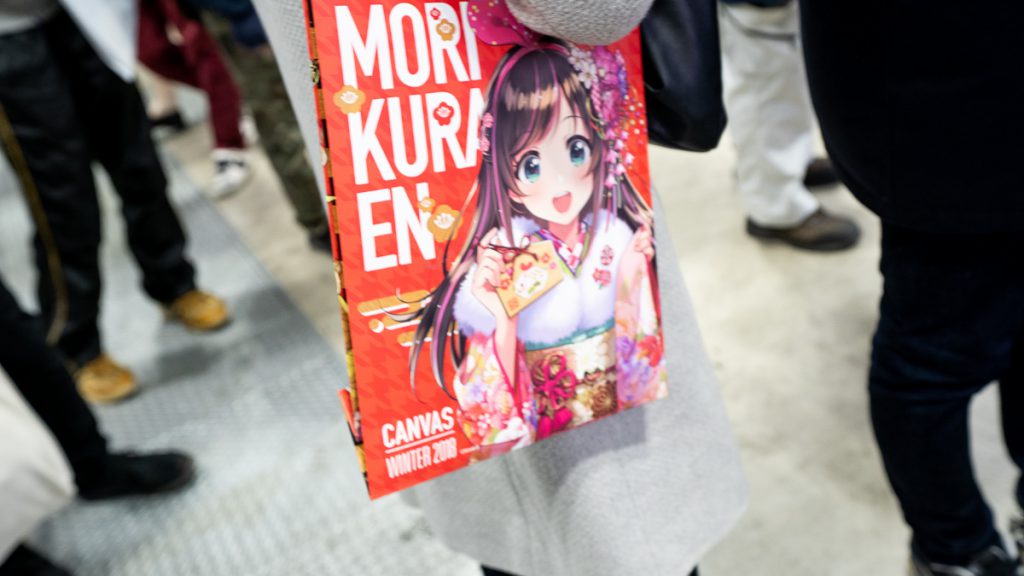
Comic Market was first created in 1975 by famous manga critic Yoshihiro Yonezawa and the other members of his doujin circle, Meikyu while they were students at Meiji University. Around that period, the manga magazine COM had just shut closed down. COM was launched by Hayao Miyazaki a decade prior to showcase experimental and manga works, his own masterpiece Phoenix, for example. It was a time when the manga market and publishing was dominated by large companies and alternative, non-mainstream works couldn’t receive much attention.
The first ten years of Comiket’s history were marked by a rapid rise in popularity. By the 18th iteration, there were 500 circles involved, and as many as 10,000 participants. Those years were marked by a surge in popularity of shojo manga (manga for young girls), most notably of the so-called Year 24 Group, which is the name used to describe the major actors of the female manga artist scene around the year 1949 (year Heisei 24 in the Japanese calendar). In addition, most doujinshi at the time were original stories. Fan fiction had not yet become the norm.
By the 30th iteration, they had reached 4000 participating circles, and 35,000 attendants. Doujinshi circles went from membership based to small circle-based ones, and printing advancements and increases in services catering their needs drastically lowered the price to print their work. In addition Captain Tsubasa’s boom in popularity played a role in driving younger people to make doujinshi, lowering the median age.

The late 80s is where the most massive shifts happened. 1989 is a significant year in Japan’s otaku subculture. The crimes of the serial killer Tsutomu Miyazaki caused a massive backlash against otaku culture which was vilified and deemed to contain dangerous society deviants. This however led to an increased exposure for Comic Market, which was already gaining popularity. By 1990, there were 13,000 participating circles, and 250,000 attendants. In addition, circles switched their focus to single author based circles, where members mostly worked on their own personal works. That is also the time doujin artists could start making a living out of their independently made works, thanks to the opening of various doujinshi shops and the increased market size.
Today, Comiket has 30,000 participating circles, and over half a million attendants. It has become much more than just an independent manga-only convention. Manga currently occupies about 20% of all products, with video games and anime take the rest of the lion’s share. Interestingly though, 16% of the products are neither, and can be broken down into music, literature, DIYs, crafted goods, figurines, studies, etc. Thanks to the internet and social media, circles can announce they will be present at Comiket, attracting fans to come to the event.
The Upcoming Comiket 97
Comic Market 97 will be held from December 28th to December 31. Like for the previous iteration, due to preparations for the Tokyo Summer Olympics, Comiket 97 will be held between Tokyo Big Sight and Aomi Exhibition Hall a little further for corporate booths. If you are planning on coming, remember you will have to walk 15 or so minutes between both locations and plan accordingly.
COSPLAY AT COMIKET IN JAPAN
Comic Market sees a lot of cosplayers coming to exhibit themselves, and their costumes. A main reason they come is to become famous. Many photographers from magazines, as well as many agency representatives are present during the event looking for new talents. It’s not uncommon to see cosplayers act in a very business-like way after you take their picture in hopes you might be a head hunter and want you to remember them.
Check out more pictures of cosplayers at Comiket95!
There you’ll also see more popular cosplayers. Known Japanese cosplayer Enako, for example is there every iteration. She is so popular it’s impossible to get a one on one photo session with her and photographers have to surround her to take pictures. Because Comic Market is an indie event, she does not have to share her revenue with her agency and can make up to 20,000,000 JPY (127,703.38 USD) in two days during Comiket by selling photobooks and other merch. This is quite sizeable, considering she makes 30,000,000 JPY per year (191,555.07 USD).
COSPLAYING AREAS AT COMIKET
Most cosplaying takes place between 11:00 and 13:00. Afterward, it slowly dies down.
- The entrance plaza is packed with cosplayers and is a really good spot to take pictures. That area is however really crowded before 12.
- The garden area also has a lot of cosplayers but is really crowded after 12.
- the rooftop is only open from the second day. It’s less crowded and easier to move around.
- The East Hall outside the sales area has some cosplayers, but not as much as others.
- The parking to the east of Tokyo Big Sight also has lots of cosplayers.
To the north east of Tokyo Big Sight, there is a park with many cosplayers. In addition, after the cosplaying time is over, many flock there from Tokyo Big Sight.
HOW TO PARTICIPATE IN COMIKET AS A COSPLAYER
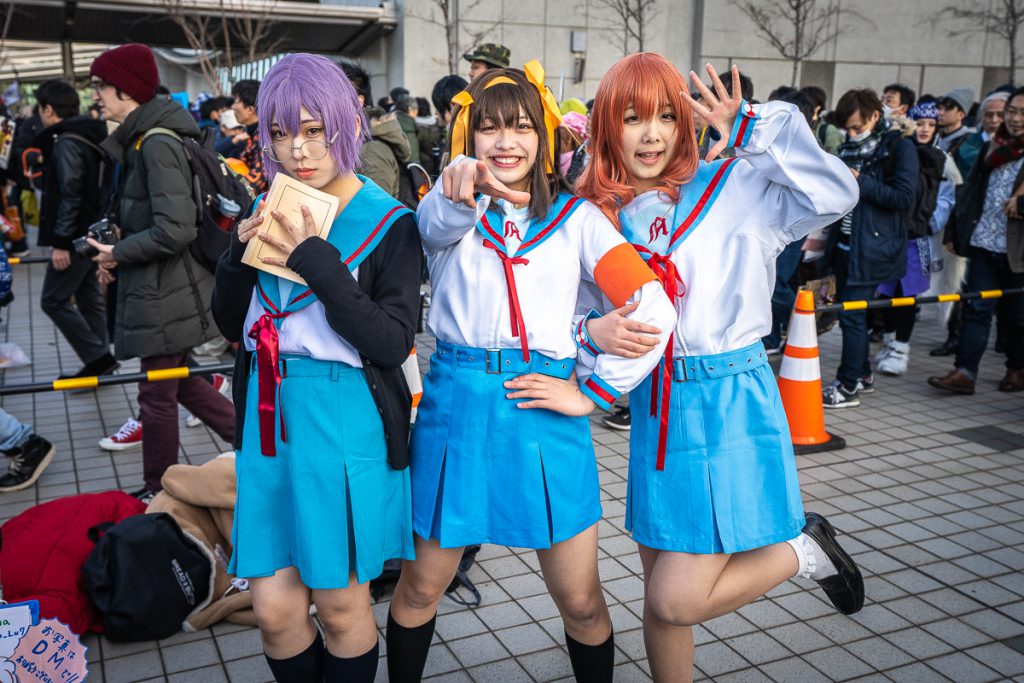
If you want to participate in Comiket as a cosplayer, of course, you can! There a couple things you need to know first, though.
REGULATIONS TO FOLLOW WHEN COSPLAYING
Because to the organizers of Comiket, cosplay is an essential part of doujin culture, they strive to respect all cosplayers rights to physically and visually express themselves. However, there are certain rules to follow. Here are the rules stipulated in Comiket 94’s Official Catalog.
Rules of cosplay at Comiket
- If you wear a swimsuit or leotard, please make sure to cover your body when you walk in public places.
- If you bring items like weapons. please hide it in public places.
- For a garden(=庭園) or entrance plaza(=エントランスプラザ), it’s strictly prohibited 1. costumes which look like underwear like a swimsuit, 2.using sexual words which other people may not feel comfortable to hear.
- You must change your clothes to costumes when you arrive in Comiket. Needless to say, you must change your costumes to clothes before leaving from Comiket. There is a changing room (*We will explain it later)
- Costumes which risque an indecent exposure is strictly prohibited, such as showing underwear.
- You should not bring any costumes or items which may destroy the facility. (Including Items which are not dry. )
- You must wear underwear even if you put a swimsuit.
- You’d better put a stoking or tights if you have a risque to show your underwear.
- When you are leaving from cosplay are, you must make sure to take off items, masks, capes, etc.
- If your cosplay looks like some official works, such as policeman, etc, you must put a coat when you are in public place. Also, you are not allowed to pretend itself.
- You must avoid your behavior which may bother other people
WHAT TO DO ON THE DAY YOU COSPLAY AT COMIKET
When it’s the day of your cosplay at Comiket, please follow those steps below. Don’t be afraid of participating in Comiket as a cosplayer even if you’re just a tourist. In fact, many foreign cosplayers are there.
- Please do not wear any costume until you arrive at Comiket. Bring your costumes with you in a bag or suitcase.
- Once you arrive at Comiket, first please register your at the office. To find the office, please look for the words “コスプレ登録”. After registering, you can get a certificate, called “コスプレ登録証” so please make sure not to lose it and keep it with you at all times.
- Change into your costume. There are changing rooms that you can use, by showing your certificate. When you register, people will let you know which changing rooms are available. After changing your clothes, you can go to the baggage claim area (information below).
- Once you are ready, you’re all set to cosplay. If you want to have your photos taken, it’s a good idea to bring a board with your twitter/instagram handle on it.
- After cosplaying, change into your everyday clothes and you can go back home to sleep.
HOW TO USE A BAGGAGE CLAIM AREA
If you’re participating as a cosplayer at Comiket, chances are you’ll need to store your stuff somewhere. there is a cloakroom service where you can store your luggage and personal belongings. Look for 手荷物預かり in Japanese. although it’s usually also written in English. Note that once you’ve checked something in, you cannot add stuff to it. You’ll have to check them in again, and pay again. Prices are as follow (as of Comiket 95):
- Small suitcase (h + l + w up to 120 cm) – ¥500 (~$4.50)
- Large suitcase (h + l + w between 120 cm and 180 cm ) – ¥800 ($7.20)
- Cardboard box (h + l + w up to 180 cm) – ¥1200 ($11)
- Coat – ¥300 ($3)
THINGS TO KNOW BEFORE GOING TO COMIC MARKET IN JAPAN

Comic Market plays a big role in today’s otaku world for various reasons. First because it provides an opportunity for fans of doujin circles to meet the artists behind the works they enjoy consuming. Various creators will make limited edition items that can exclusively be found at Comiket. Each year, there is a frightening rush as soon as the doors to the even open, a quasi-race to first get to the doujishi before they run out. Finally, there’s the cosplay. Comic Market has become one of the most important cosplaying events. Hundreds of cosplayers work tirelessly to create costumes for the event. These include hobbyists and some which are really famous. Professional photographers are present to take pictures of them, and the less popular ones can gain popularity in the event.
1.COSPLAYERS

As I’ve said, Comiket is one of the major cosplaying events in Japan. There are hundreds of cosplayers dressed in high quality costumes, often that they’ve made themselves, and photographers there to shoot them. If you’d like to take their pictures, there are a few things you should know. There may be a line to take pictures. Line up and wait your turn, and greet them before taking any picture. DO NOT take pictures if you haven’t lined up and it’s someone else’s turn to take pictures. If there is no line, ask the cosplayer if it’s ok to take pictures. A simple “picture ok?” suffices. They will often have a board with their twitter handle on it. Take a picture of that as well. If you have taken any good picture, they’ll be glad if you send it to them on twitter afterwards.
2. HOW TO BUY A SPECIFIC GOOD
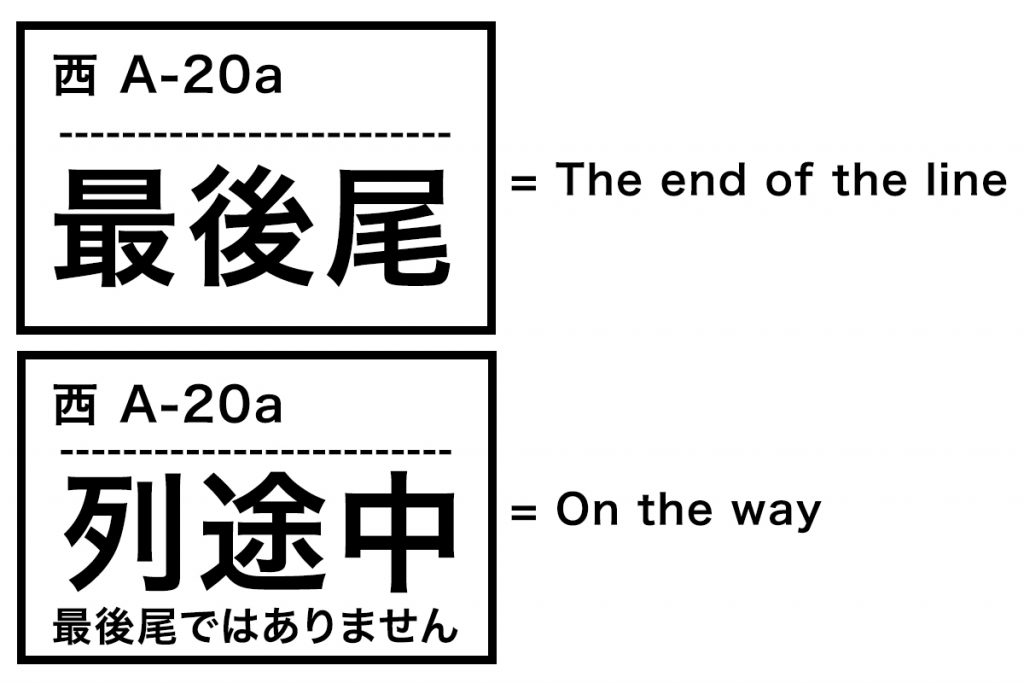
Regular attendants to Comic Market come with a plan. Artists will generally tweet what their booth location is ahead of the event, along with what they’ll have in stock. In addition, a catalog is published ahead. Some of these items are limited editions, and there is a race to get them. If you really want something, know where the booth is, arrive early, and RUSH! If you’re not there for anything specific, feel free to just roam around.
Make sure: When you want to buy something and find a line, please check if you are at the end of the line. Like images above, please find a panel.
3. THE TRAIN STATIONS NEAR TOKYO BIG SIGHT ARE EXTREMELY CROWDED

On the days of the event, the stations are really crowded. This can be a bit scary for those who are not used to it. Remember, half a million people attend the convention. Be prepared to have to move very slowly between the station and the convention center. If you want to make a stop at the convenience store, do so before you get there, the lines there will also be really long.
In addition, make sure your Passmo or Suica card is charged for the round trip. The lines at the station to top up your cards will be gnarly.
4. SOME AREAS ARE NOT FOR KIDS
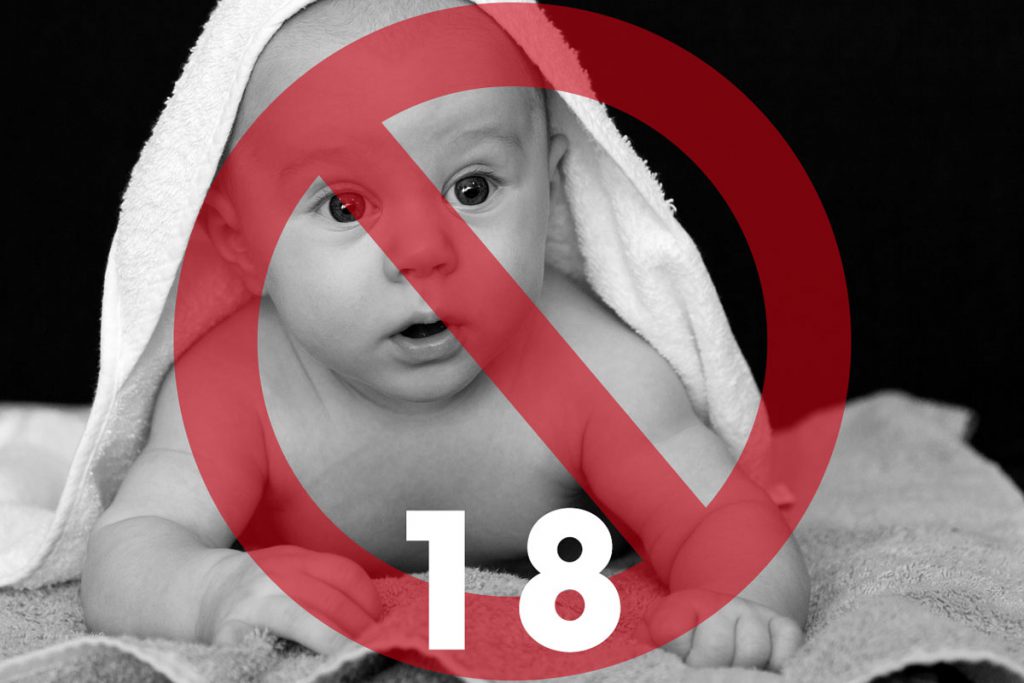
A large amount of doujinshi have explicit content. Those of you in the normie end of the scale may be tricked by the cute, innocent looking drawings, but they may very well be erotic, if not pornographic by nature. If you are with kids, watch where you’re going.
5. BRING WATER AND CHANGE

On the days of the event, the stations are really crowded. This can be a bit scary for those who are not used to it. Remember, half a million people attend the convention. Be prepared to have to move very slowly between the station and the convention center. If you want to make a stop at the convenience store, do so before you get there, the lines there will also be really long.
6. SOME OF THE ITEMS ARE AVAILABLE ONLINE
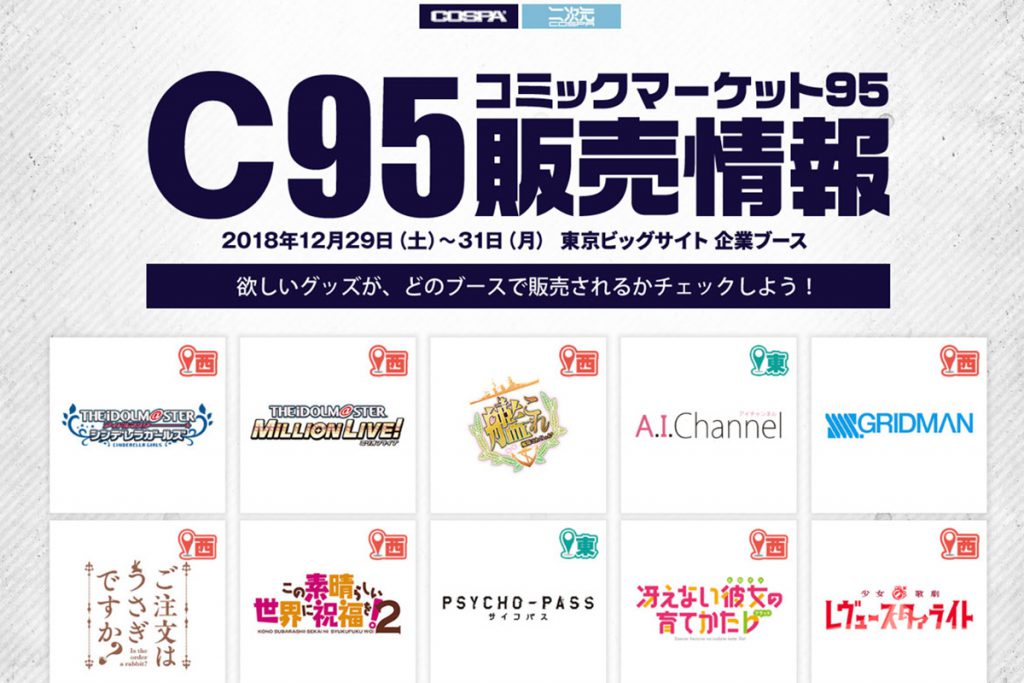
A large amount of doujinshi have explicit content. Those of you in the normie end of the scale may be tricked by the cute, innocent looking drawings, but they may very well be erotic, if not pornographic by nature. If you are with kids, watch where you’re going.
COMIC MARKET 96-98 WILL BE CHANGED DUE TO THE TOKYO 2020 OLYMPIC

From Comic Market 96 until 98, there are many changes. This is due, for the most part, because of the upcoming Tokyo 2020 Summer Olympics. We went to Comiket 96 to see the changes for ourselves, and detail them below.
LOCATION FOR COMIKET 96-98

Before 2019, Comiket had been using the East Hall, which can no longer be used. From Comiket 96, it will be held in the West and South halls, and simultaneoulsy in Aomi Tengito temporarily during Tokyo Olympic.
- circles = West and South Hall
- Industry = Aomi Tengito (青海展示棟)
South Hall is right behind West Hall but Aomi Tengito will be about 1.5km away from the other halls. It’s near the Tokyo Teleport Station (=東京テレポート駅). It will be the first time Comiket will be held in two different venues. In total, Comiket will only be about 75% as large because of this.
All in all Comiket 96 isn’t much different from 95. Just the walk between the main halls and Aomi is really painful, especially in the heat, so bring water.
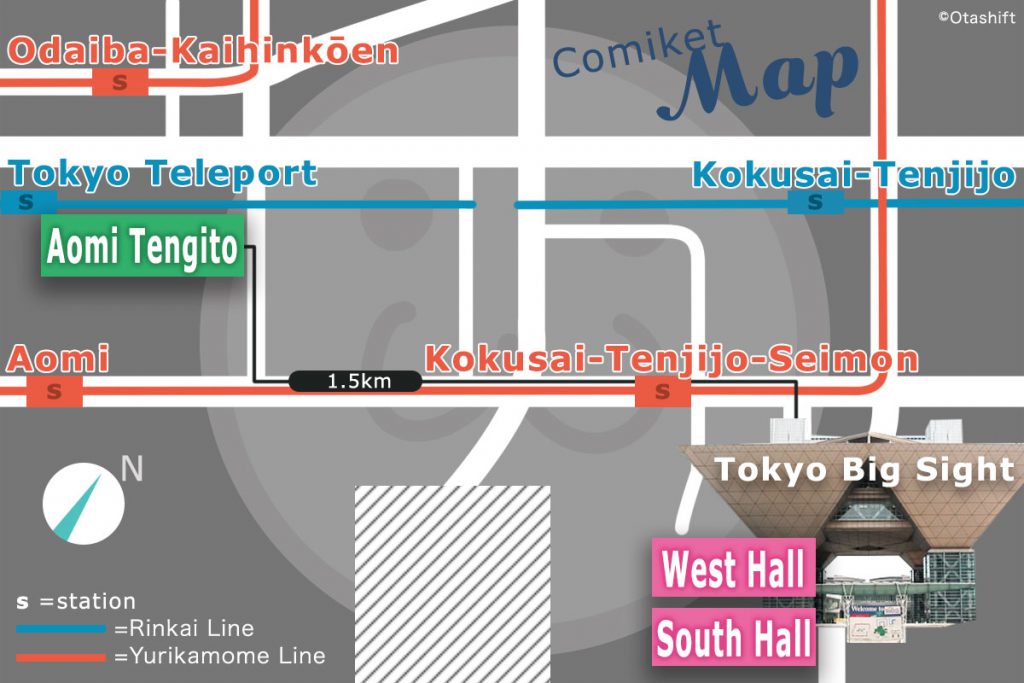
The different dedicated areas of Comic Market each have different opening hours.
* Comic Market 96: 9th August to 12th 2019
* Comic Market 97: 28th December to 31st 2019
* Comic Market 98: To be announced. But will be during Golden Week.
Both Comiket iterations held in 2019 will last FOUR DAYS! This is the first time this ever happens. Because of East hall’s unavailbility limiting the number of participating circles, there will about 75% of what was seen in previous years.
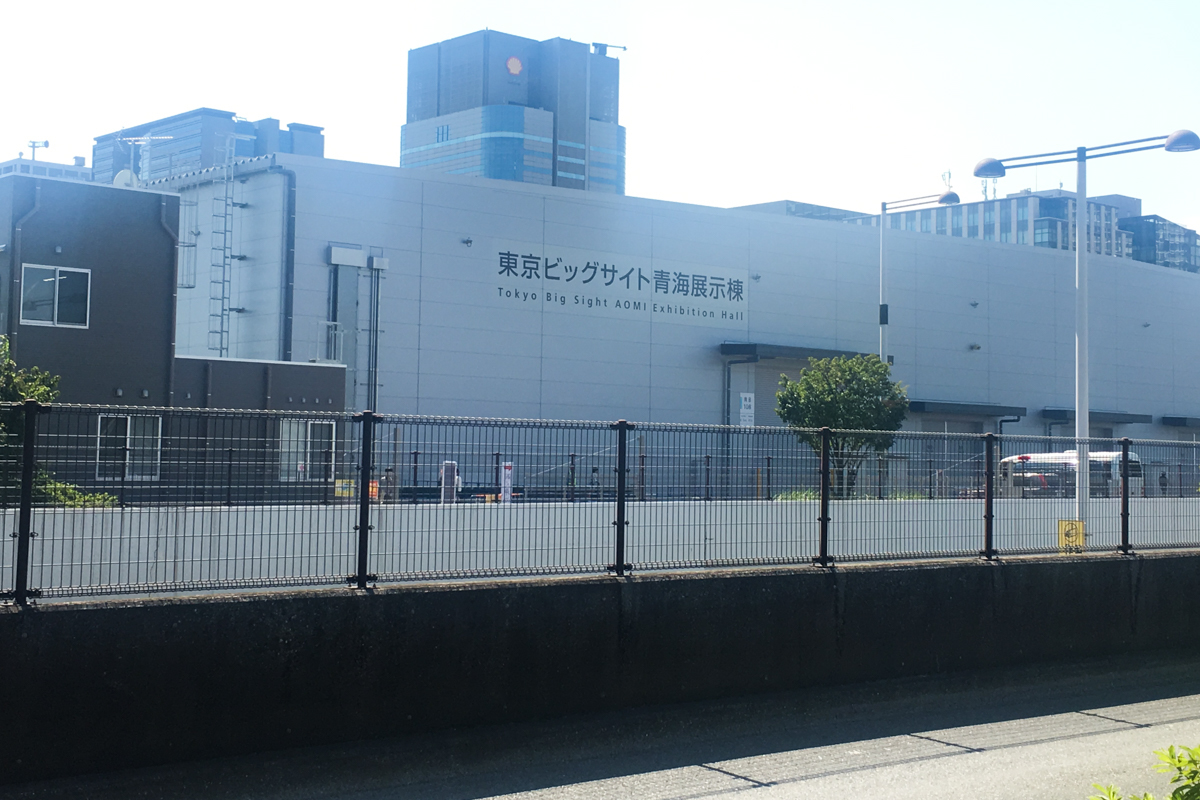

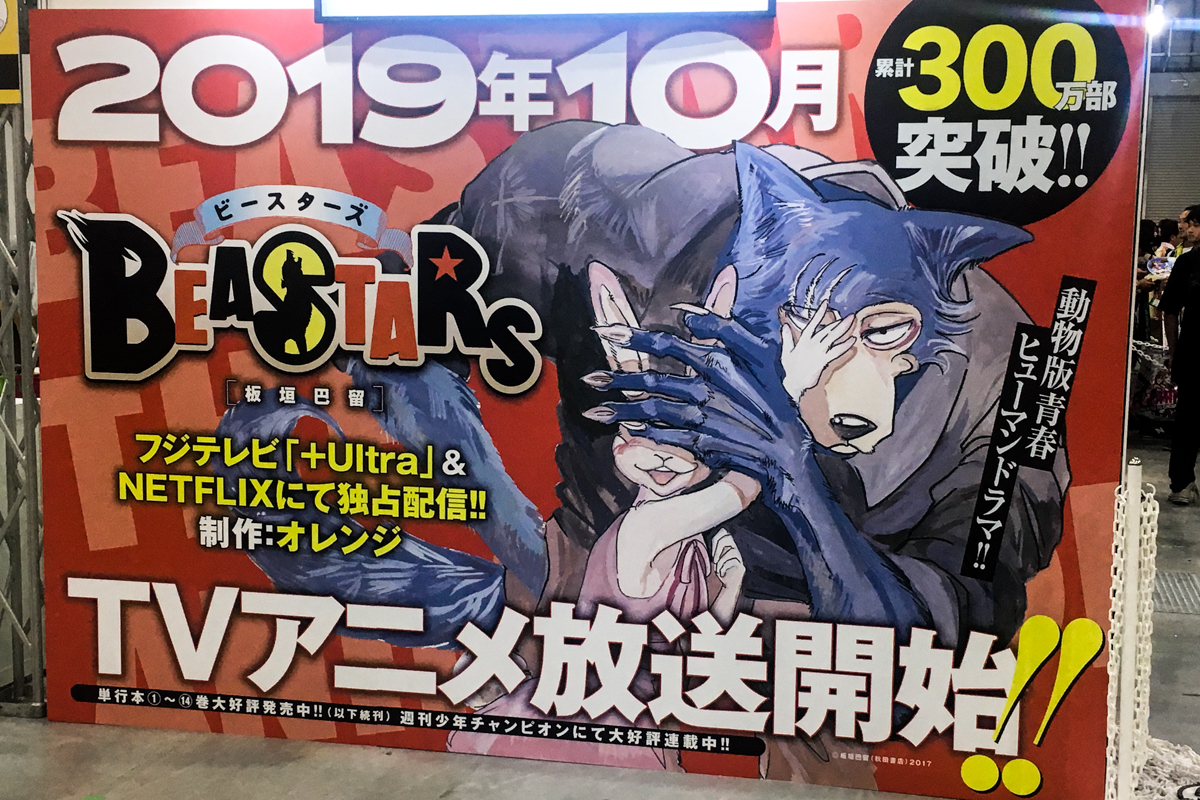

NEED TO PAY FOR ENTRANCE OF COMIKET

For the first time, Comic Market is no longer free. A wristband is required for entry. You can get those in one of the following three ways:
- Four-day’s worth of wristbands are included in the Catalog for ¥2500 ($24) in bookstores or ¥2000 ($19) at Comiket
- Wristbands can be purchased at specialty anime/manga stores (for a slightly higher price of ¥540). You can find those in stores like Comic Toranoana. Check out our article for a guide on anime/manga shops in Akihabara.
- Wristbands can be bought on site for ¥500/day ($4.70).
Each day requires a different pass. They are color coded and the specific day is written on them (see picture below).
SO HOW ABOUT AFTER COMIKET 98; COMIKET 99?
After Tokyo Olympic 2020, East Hall will be available again, so for winter Comiket 99, back home! Comiket 99 may use all the East, West and South halls, so 16 halls in total. However, we are not sure of the details yet.
Furthermore, 2021 will be an important year for Comiket because it will be Comiket 100 in summer.
COMIC MARKET 95 IN JAPAN

The latest Comiket at the time of writing took place between December 29th and December 30th, 2019. We went on the last day. I had been going to Comiket since 2014, and this one was not much different from then. There seemed to be a much bigger focus on certain newer medias such as virtual youtubers, which are becoming increasingly popular in Japan nowadays.
VIRTUAL YOUTUBERS AND ATM TRUCKS

In 2018 at Comiket, there was a noticeable increase in streaming and youtubing based content. In particular, there was a significant portion attributed to virtual youtubers, who were present during the conference (virtually).
In addition, big private companies are also seeing Comiket as a big advertising ground. 7-Bank had brought an ATM truck inside the ground. This is no regular ATM. The vocal commands are carried out by famous anime voice actors, which is a service they had started testing for the general public.
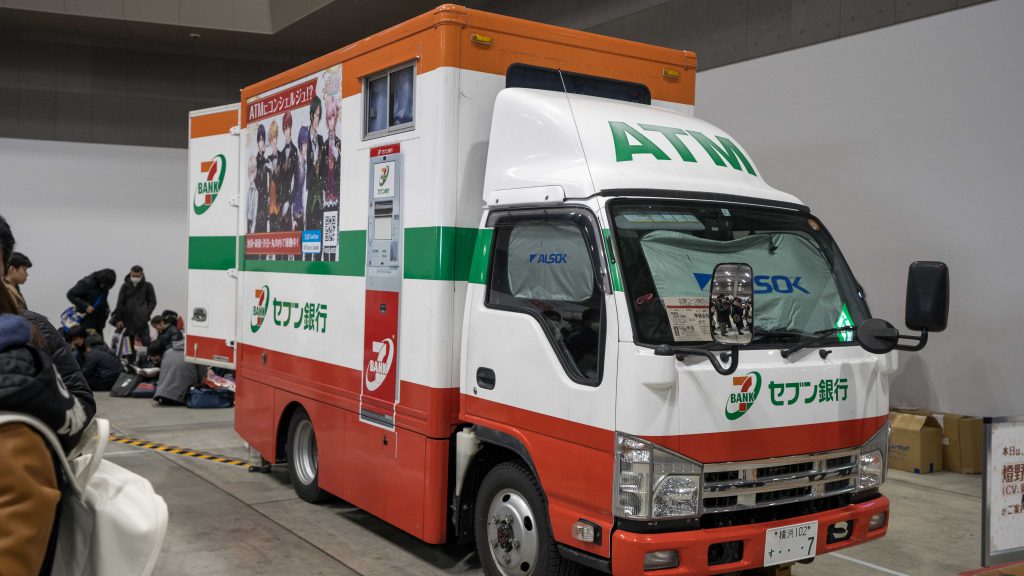
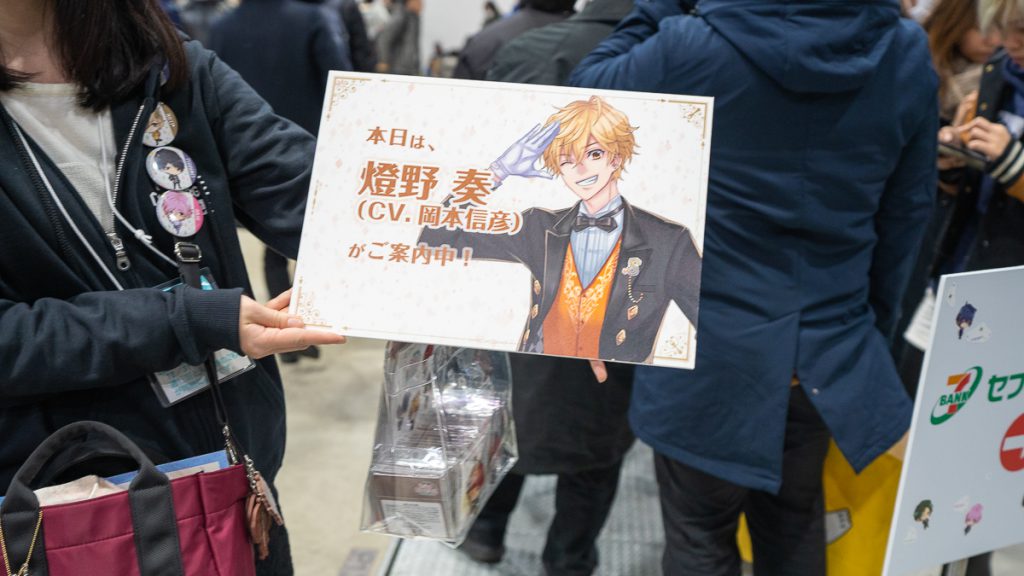
IS IT WORTH GOING TO COMIC MARKET?
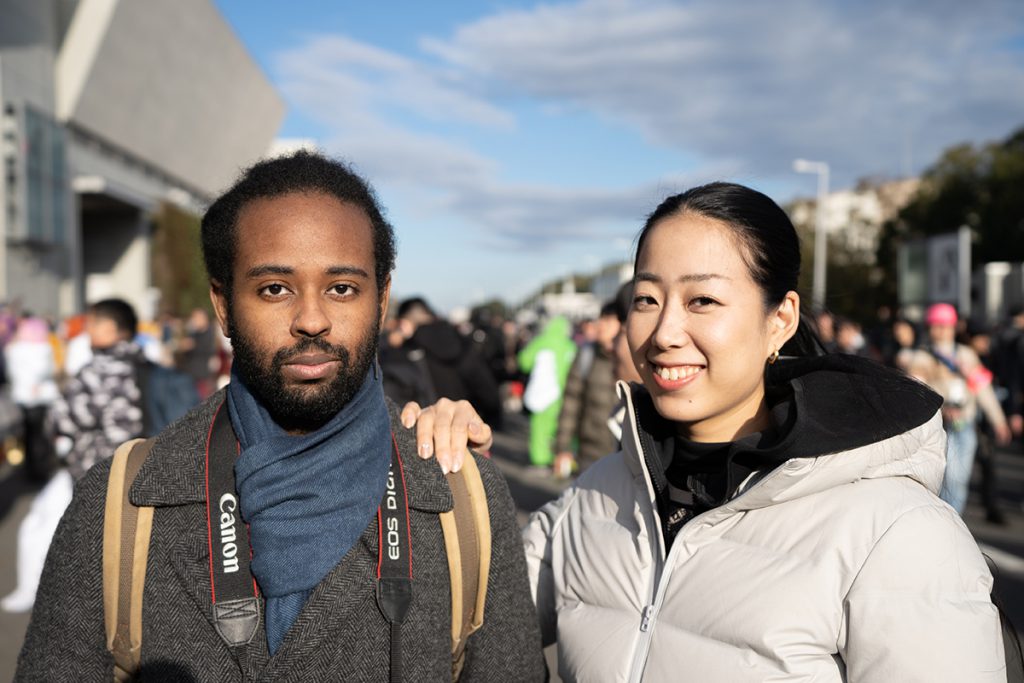
While I wouln’t recommend planning a trip for the sole purpose of going to Comiket, if you find yourself in Japan while it’s happening, I’d say you should go. That is, of course if you are part of the fanbase. If you’re a cosplayer or artist yourself, then you may have more reasons to go.
In addition, although there are many foreign attendants nowadays, most circle’s work does not cater to them. What this means is that an almost absolute majority of the content is in Japanese. I myself have yet to find anything in English, in 4 years of going to Comiket. If you are a fan of doujinshi, however, especially if one of the artists you’re fond of is there, then absolutely go. You get to interact with them, and purchase limited edition items.
Those who are not into the otaku subculture may have difficulty finding the place of interest. But if you’re up to seeing a different cultural side of Japan, beyond tea ceremony, flower arrangement, and other refined things Japan is known for, but a cultural side, just as important in the eyes of those who partake, then absolutely go. You may find non-anime/manga related craft goods and artwork which you might like, as well.






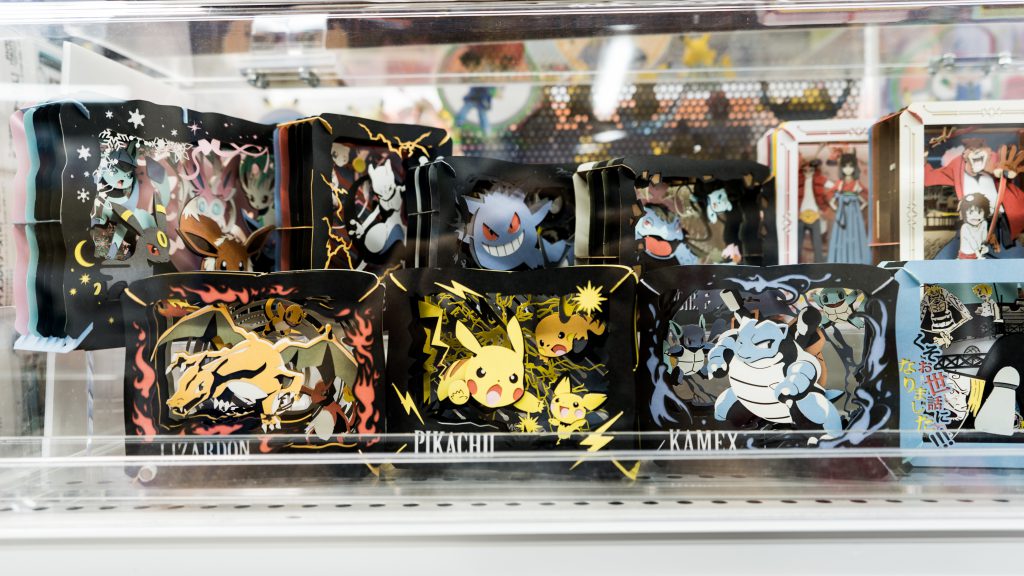


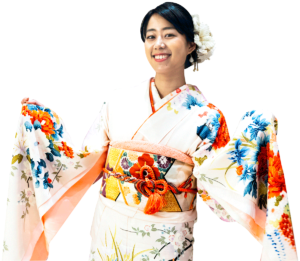



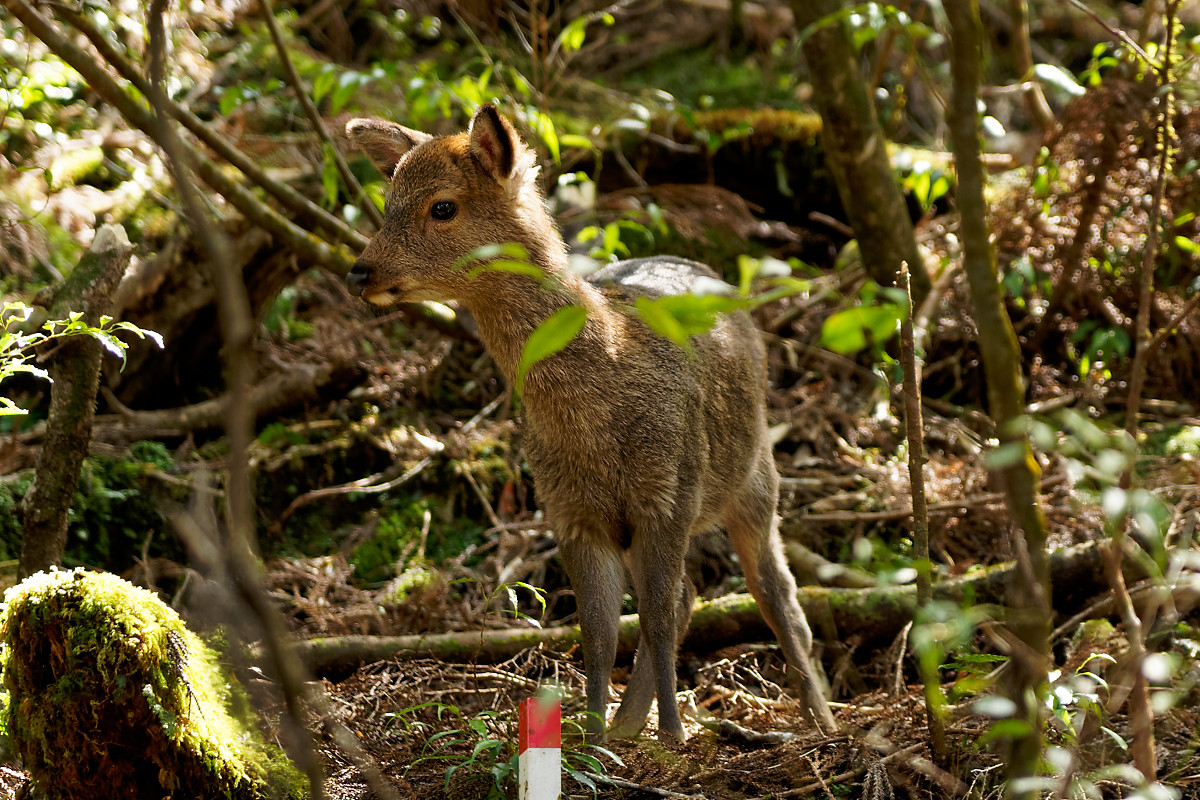


We will be going as cosplayers next winter. Your article is very helpful! Thank you so much!!
Thanks for reading. Enjoy your time here!